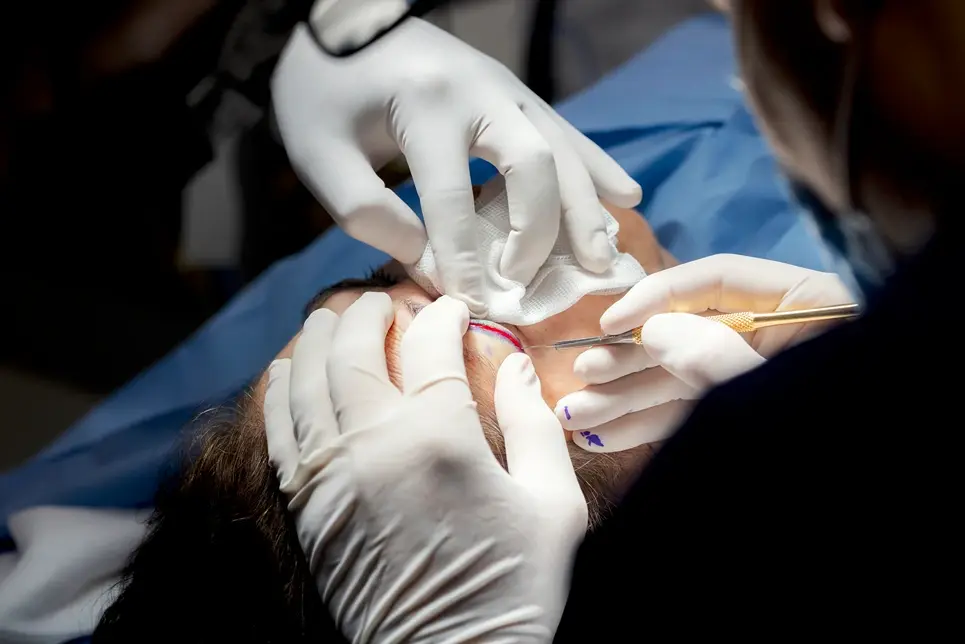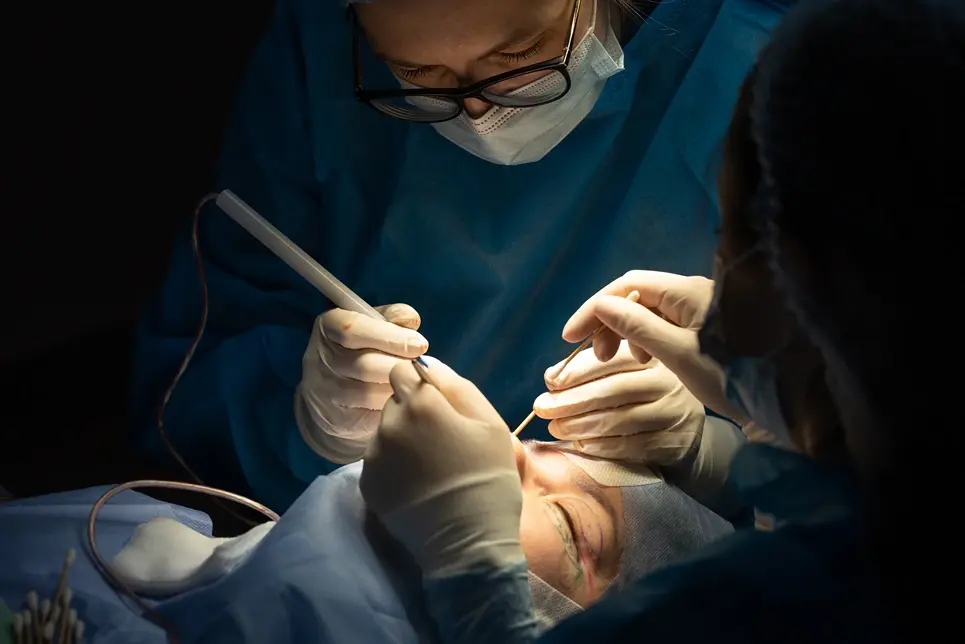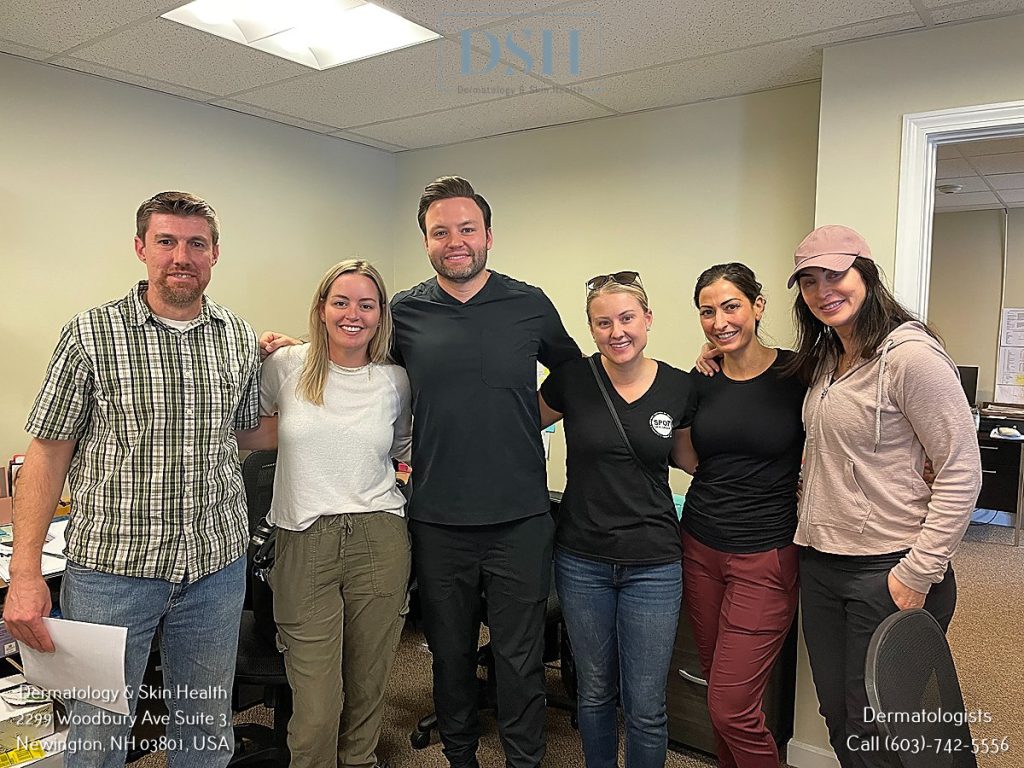


Mohs surgery is often used to treat skin cancer above the eyebrow. This precision technique removes all cancer cells while sparing healthy tissue to minimize scarring in the delicate eyebrow area.
Skin cancer, including basal cell carcinoma and squamous cell carcinoma, is common above the eyebrow area. This delicate region around the eyes requires precise and effective treatment to remove cancerous cells while minimizing damage to surrounding healthy tissue. Mohs surgery has become the treatment of choice for these complex cases.
Mohs surgery, named after Dr. Frederic Mohs who developed the technique in the 1930s, involves incrementally removing layers of skin and examining them under a microscope during the procedure. This process allows the surgeon to precisely map out where cancer cells remain while sparing as much healthy tissue as possible.
The Mohs surgery process consists of the following steps:
Mohs has the highest cure rate of any skin cancer treatment, up to 99% for certain tumors. It allows comprehensive analysis of 100% of the surgical margin, while other techniques only sample a few small portions. This meticulous approach helps ensure no roots or extensions of the tumor are left behind.
The skin above the eyebrow is challenging to treat thoroughly while avoiding damage to critical structures nearby. This area contains hair follicles, sebaceous glands, and intricate nerves and blood vessels feeding the eye and forehead. Skin cancers here can also extend delicate roots along nerve paths.
Standard excision of skin cancers relies on clinical margins and microscopic examination of only a small sample of the tumor margins. This does not always provide a comprehensive assessment of potential cancerous extensions from the main tumor body.
In comparison, Mohs surgery involves complete margin examination and additional stages if needed, allowing unparalleled precision in tracing out any residual cancerous areas. This results in the highest chance for clear margins while removing the least amount of normal tissue.
Mohs surgery preserves key nerves, blood vessels, and other anatomical structures critical for function and appearance around the eyes. It helps minimize scarring and deformation compared to alternative techniques. For these reasons, Mohs has become the treatment of choice for skin cancers near delicate or highly visible facial areas.

The Mohs procedure itself takes place in the dermatologic surgeon's office under local anesthesia. You will remain awake during the procedure.
After the initial visible tumor is removed, you will wait about 1 hour between each stage while tissue is processed and examined under a microscope. Typically 1-2 stages are required for tumor removal, but it may require several more for larger or complicated tumors. The process can take 3-6 hours total to complete that day.
Once clear margins are confirmed, the surgical site will be closed with stitches. Various reconstructive options can optimize appearance after Mohs above the eye. This may involve simply stitching the edges together, transferring a nearby skin flap, or even grafting skin from another part of the body.
After the surgery, you can expect:
Your doctor will give you specific wound care instructions. Most patients heal within 2 to 3 weeks with proper care and are able to return to regular activities after this initial healing period. Strenuous activity and exposing the site to sun should be avoided for 1-2 months.
One of the biggest concerns with surgery near the eyes is the resulting appearance and scarring. There will be a scar after the tissue is stitched together, but several factors influence how visible or noticeable the scar will be:
For smaller defects, direct closure techniques result in fine line scars that heal nicely and blend with natural eyebrow hair regrowth over time. The eyebrow can be micro surgically reconstructed for larger defects. Patients should discuss reconstructive options with their surgeon to optimize appearance after Mohs surgery.
With Mohs, surgeons can preserve nerves important for maintaining eyebrow movement and position. This avoids a droopy brow or distortion that can occur with other techniques. Most patients experience excellent functional and cosmetic outcomes with Mohs surgery with minimal impacts on their appearance.

While Mohs surgery is extremely precise, there are still risks and the potential for complications:
| Bleeding | Oozing and minor bleeding is common after surgery but major bleeding is rare. Applying pressure helps control bleeding. |
| Infection | Rare with proper wound care but may require antibiotics. |
| Poor wound healing | Smoking and certain medications impair healing. Follow wound care instructions closely. |
| Nerve damage | Temporary or permanent numbness can occur but is minimized with Mohs technique. |
| Eye injury | Very rare but precautions taken to avoid any eye damage. |
| Recurrence | Up to 5% of tumors may recur and require additional treatment. Lifelong skin checks are essential. |
These risks are quite low with an experienced Mohs surgeon. Make sure to speak with your doctor about any concerns or potential complications before the procedure. Notify your provider immediately about any issues like excessive bleeding, increasing swelling or pain, fever, or other worrisome symptoms. Prompt attention ensures you heal properly.
While Mohs surgery is a highly precise technique, there are other treatment options that may be considered for skin cancer above the eyebrow:
Excisional surgery involves surgically cutting out the tumor with a margin of healthy tissue. This is a common technique but does not allow microscopic examination of 100% of the margin like Mohs surgery does. There is a slightly higher risk of recurrence with excisional surgery compared to Mohs.
Radiation therapy uses targeted radiation to kill cancer cells. This non-invasive treatment can be more convenient than surgery but it is less ideal for complex or large facial tumors. Radiation therapy can also cause local skin damage in the treatment area.
Photodynamic therapy utilizes light-sensitizing medication and special lamps to activate the medication. This treatment is limited mainly to very superficial skin cancers. Photodynamic therapy requires multiple treatment sessions to be effective.
Topical creams show promise in treating early skin cancers but generally have low success rates when used alone on established tumors. These creams can also irritate surrounding healthy skin when applied.
Curettage and electrodesiccation involves scraping away the tumor with a curette tool and then cauterizing the area. This technique can damage healthy tissue around the tumor site during treatment.
These alternatives may play a role but most dermatologists prefer Mohs surgery for cancers above the eyebrow given its higher cure rates, precision, and optimal cosmetic results. The choice depends on factors like the tumor size, complexity, and patient preferences.

In summary, Mohs surgery provides the greatest precision and highest cure rates for skin cancers located above the eyebrow. This delicate area near the eyes requires a treatment focused on maximizing cancer removal while preserving normal tissue.
The methodical nature of Mohs surgery with complete microscopic margin examination allows surgeons to comprehensively remove cancerous extensions while protecting critical nerves, blood vessels, and other facial structures. This minimizes scarring and risk of recurrence compared to other techniques.
Patients can feel confident that Mohs surgery gives them the best chance for clear margins after treatment of an eyebrow skin cancer. Working closely with their dermatologic surgeon helps assure optimal outcomes and appearance after surgery. With Mohs surgery's excellent cure rates and cosmetic results, patients can have effective treatment with the peace of mind this challenging area has been addressed thoroughly.
For optimal skin cancer removal and the best cosmetic results, consider Mohs surgery above the eyebrow with Dermatology and Skin Health. Experience expert excision from Dr. Gary Mendese.
If your desired appointment type or preferred provider is unavailable online, kindly call (978) 525-0100 for Peabody, MA and (603) 742-5556 for all New Hampshire locations. Alternatively please feel free to send us your request via the patient portal, or via email at info@dermskinhealth.com
*For medical dermatology appointments in MA please dial (978) 525-0100 or fill out the appointment request form above.